Toucans are one of my favorite birds and Costa Rica is a great place to see them. There are 6 toucans in Costa Rica: Keel-billed toucan, Black-mandibled toucan (Yellow throated), Yellow-eared toucan, Fiery-billed Aracari, Collarred Aracari and Emerald Toucanet.
In this post, you’ll find out some toucan facts and the best places to see toucans in Costa Rica. When it comes to spotting these birds, you will most likely hear them before you see them as they are quite vocal birds with a unique call.
They usually are in large groups so if you see one, you most likely will see more. We have seen 5 out of 6 toucans in Costa Rica, we are just missing that sneaky Yellow-eared!
This post has affiliate links which we may earn a small commission from if you choose to purchase, at no extra cost to you. Any prices listed in this post may not reflect current prices of present. It is the readers responsibility to research and consult for current pricing. Prices are quoted in USD and are an estimate.
Costa Rica Toucan Facts
Toucans have oversized beaks, travel in small groups and are omnivores. They eat fruit, berries, insects and eggs/nestlings of other birds. They travel in groups and always in pairs when they’re adults.
You’ll notice that toucans will exhibit a follow-the-leader behavior, whenever one toucan flies off, the others will follow a few seconds later so if you’re a wildlife photographer, if you see one fly off, you can then predict which direction the others will fly off too. They usually follow each other within minutes.
When their territories overlap, it is common to see different species of toucans together. We’ve seen Keel-billed, Chestnut-Mandibled and Collared Aracari toucans in the same tree!
Emerald Toucanet
Of the 6 toucans in Costa Rica, the Emerald Toucanet is the smallest standing at 12 inches (30 centimeters). This is the only toucan with a green chest and stomach and they are hard to see since they’re so small and bend in well in the trees.
They also have a distinctive dark blue throat, making them different than the other Emerald Toucanets found in Mexico and South America. Some classify them as a subspecies of the Emerald Toucanet and call them Blue-throated Toucanet.
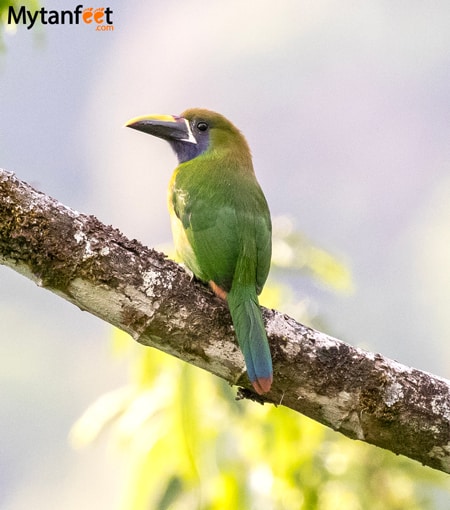
They’re live in elevations from 2600-8000 feet (800 to 2400 meters) and are commonly seen in Monteverde, Turrialba and in the Caribbean mountains. These toucans are also found in Nicaragua and western Panama.
We saw Emerald Toucanets in Monteverde at the Children’s Eternal Rain forest Bajos del Tigre station and around our Monteverde Airbnb. We also saw them up in the mountains of Turrialba, specifically the small community of Santa Cruz.
Collared Aracari
The Collared Aracari toucan stands 16 inches tall (41 centimeters) and look very similar to the Fiery-billed Aracari except for the mandible. The Collared Aracari has a white beak and a black belly stripe. They have in my opinion, the cutest call!
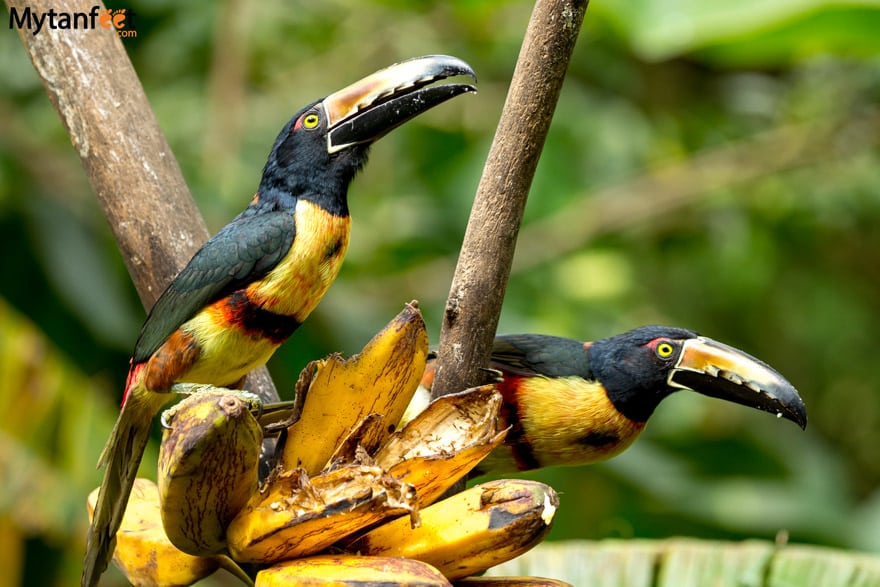
If you see one, you will most likely see more as they travel in groups of anywhere from 4-12. They are common in the Guanacaste mountain range like the Tenorio Volcano National Park region, the Caribbean coast and the Northern Lowlands such as Arenal and Monteverde. They’re usually found in elevations up to 3000 feet (1000 meters).
We’ve seen Collared Aracari toucans in La Fortuna, Bijagua and Monteverde.
Fiery-billed Aracari
The Fiery-billed Aracari toucan has the coolest name! They look like the Collared Aracaris except for their chest and beak, which have red and orange stripes instead of white (hence the name Fiery). They’re around the same size as the Collared ones as well.
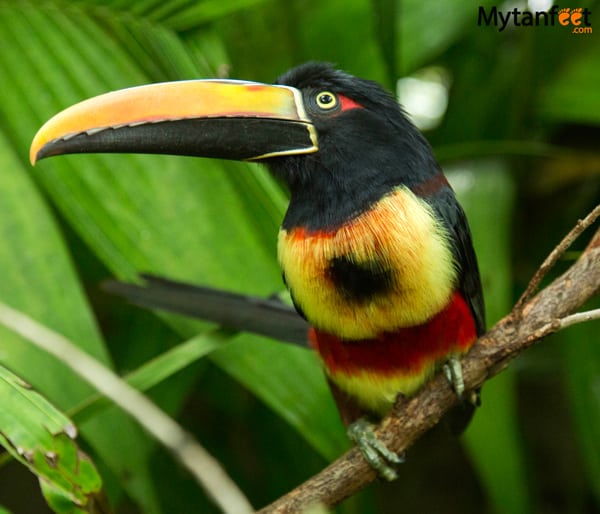
You can see Fiery-billed Aracaris only in the Central and South Pacific of Costa Rica so places like Manuel Antonio, Uvita, Dominical, Ojochal, Sierpe and the Osa Peninsula. They are endemic to Costa Rica and western Panama and don’t usually live up high in elevation.
We’ve seen them in Manuel Antonio and Uvita.
Yellow-eared Toucanet
The Yellow-eared Toucanet is the hardest toucan to see of the 6 in Costa Rica. In our many years casually birding a few times a year, I have yet to see and photograph one! This is the only toucan with a full black throat, breast and stomach but males and females are completely distinguishable (unlike the other toucans). Males have a yellow color on the side of their head whereas females do not.
Yellow eared Toucanets live in the the Guanacaste corridor to the Caribbean lowlands in elevations of 300 to 4000 feet (100 to 1200 meters).
I have talked to people who have seen them in Arenal and Monteverde. Hopefully I will be able to see one one day and photograph it!
Keel-billed Toucan
The Keel-billed toucan is the one most people relate to Costa Rica since it’s used as the symbol and logo for many companies. It’s also known as the Rainbow toucan because of the stunning colors of their beak.
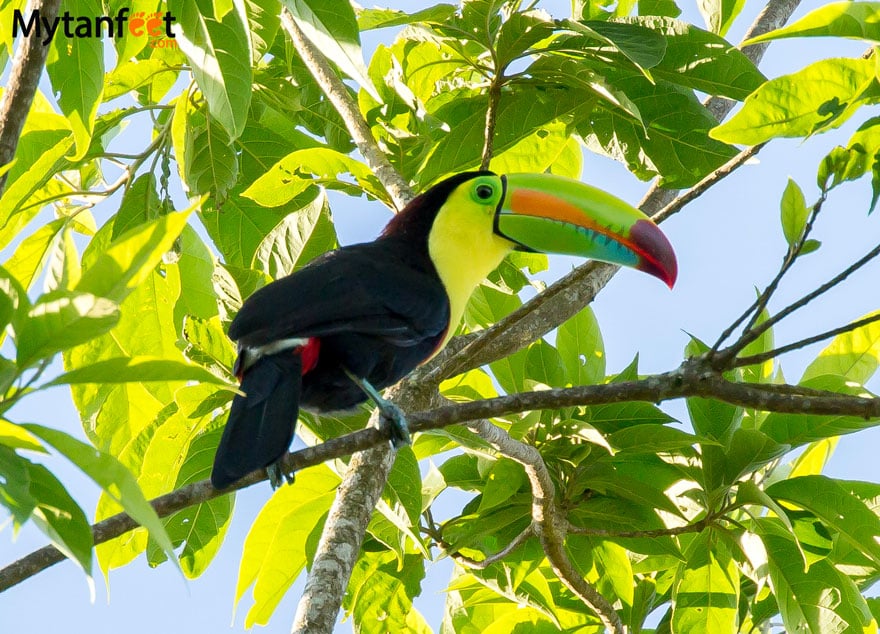
This toucan has the funniest call! Instead of a high pitch chirp, it has a croak which sounds like a frog!
You can see these toucans on the Caribbean side, in the Pacific coast mountains of Guanacaste, Monteverde, Turrialba, Cartago, mountains of the Central Valley and Arenal. They prefer an elevation of around 500-1500 meters.
We’ve seen these toucans at in Monteverde, Bijagua, Puerto Viejo, Tortuguero and Turrialba. When we stayed at Mawamba Lodge in Tortuguero, we must have seen 50 of the Keel Billed Toucans and the Yellow Throated toucans on the property!
Black-mandibled toucan (or Yellow Throated toucan)
The Black-mandibled toucan is the biggest of the 6 toucans in Costa Rican and they are known as bullies. Since they are bigger than the others, they will bully the others for food and territory. For some reason, they are known as several different names.
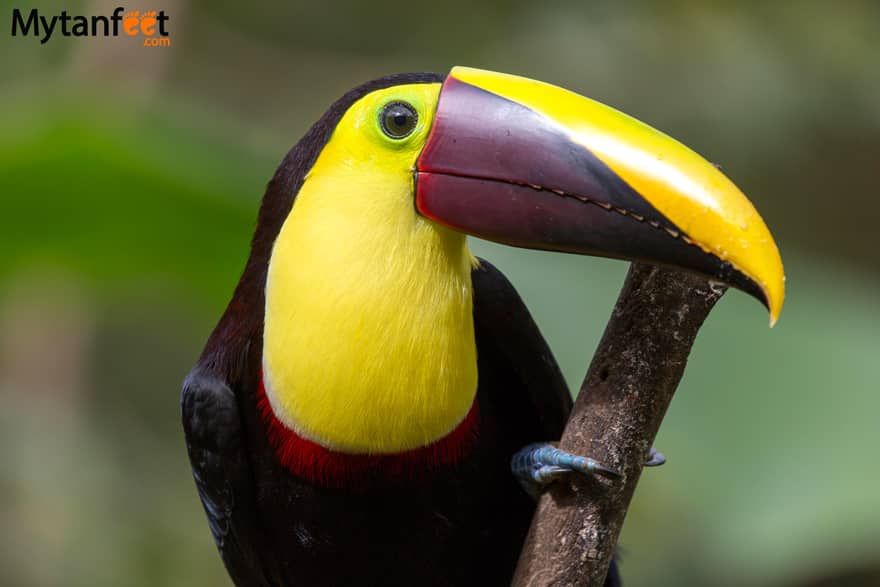
They have a high pitched call and are the most common toucans to see. They live in Arenal, Monteverde, mountains of Guanacaste (not the coast), the Caribbean side and the South Pacific.
Where to see Toucans in Costa Rica
To see toucans in Costa Rica, you don’t necessarily need to go on a bird watching tour. However, I do recommend it if you’re a birder or photographer. Some hotels are designed for specifically bird watching (observation tower, bird watching platform, etc.) such as Macaw Lodge, Danta Corcovado Lodge, Finca Verde Lodge, Trogon Lodge, Selva Verde Lodge, Villas Lapas Jungle Lodge, Maquenque Lodge and Lapa Rios Lodge.
The best places for bird watching in Costa Rica are Carara National Park, Caño Negro Wildlife Refuge, Curi-Cancha Wildlife Reserve, Palo Verde National Park, Osa Peninsula, Gandoca-Manzanillo Wildlife Refuge and Tortuguero National Park.
One of the best bird watching experience we’ve had was actually at the Airbnb we stayed in La Fortuna. This house was out in the rain forest and we saw a ton of birds! We saw falcons, toucans, tanagers, motmots and hummingbirds of all sorts.
Another one was down in the Osa Peninsula with Danta Corcovado Lodge. We saw all sorts of birds, from Macaws to Toucans, the amazing Red Capped Manakin and the stunning King Vulture from their observation tower.
If you’re a photographer, don’t forget to bring a telephoto zoom lens (at least 400mm), a steady tripod (we use Manfrotto) and gimbal head to get those sharp photos and videos. For our camera set up, I use a Canon 5d Mark III with a 100-400 mm lens and 1.4 extender. We also use our Sony mirrorless cameras with the Sony 200-600 mm lens.

Arwen Kataoka says
got any recs for seeing keel-billed toucans in monteverde?
Sammi says
We saw a whole bunch in the Curi Cancha Reserve!
Emile says
I recently moved very close to Zancudo Beach in the Southern Pacific Zone…and I often see (and hear) the Chestnut Mandibled Toucans in my yard.
I heard they were less common here in the Puntarenas Province, however I spot at least three per day and hear them throughout the day.
Pura Vida
Sammi says
I definitely see them down in the South and Osa a lot! Probably saw several everyday when we were there, and in Puerto Jiemenez one of the hotel we stayed at had a whole tree full. At least you can hear them, if you can’t see them!
Gwen says
This is the best site, it has almost the exact same thing as I saw in Costa Rica